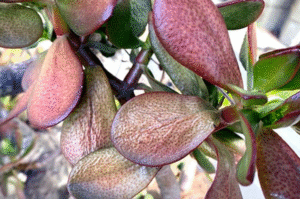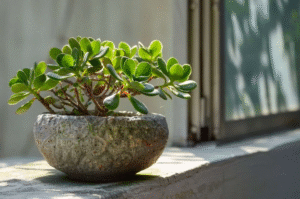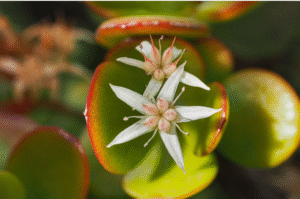If you’re exploring the world of indoor plants, one name you’ll hear often is the jade plant. But what does a jade plant look like? Why is it so popular among homeowners, gardeners, and even feng shui enthusiasts?
This article breaks it down for you clearly and easily. Whether you’re new to plant care or just curious, this guide will help you identify a jade plant, understand its key features, and appreciate its natural beauty.
What is a Jade Plant?
The jade plant (Crassula ovata) is a succulent houseplant known for its fleshy leaves, tree-like shape, and long life span. It’s native to South Africa and Mozambique, but it’s become a favorite worldwide thanks to its low-maintenance care needs and symbolic meaning of luck and prosperity.
Key Physical Features of a Jade Plant
If you’re trying to identify a jade plant in a garden center or your neighbor’s windowsill, look for the following distinct features:
1. Leaves: Thick, Glossy, and Oval-Shaped
The most noticeable part of a jade plant is its leaves. They are:
- Thick and fleshy due to their ability to store water
- Glossy green, sometimes with a reddish tint around the edges when exposed to bright sunlight
- Oval or spoon-shaped, growing in opposite pairs along the stems
- About 1 to 3 inches long
These unique leaves are a big reason why jade plants are often confused with bonsai trees.
2. Stems: Woody and Tree-Like
Jade plants develop sturdy, thick stems that resemble small tree trunks as they age. These stems:
- Start green when the plant is young
- Become brown and woody over time
- Can grow upright but also develop branching structures that give them a miniature tree appearance
This growth pattern makes jade plants an excellent choice for indoor bonsai enthusiasts.
3. Size and Shape
Jade plants come in many sizes, depending on how long they’ve been growing and whether they’re pruned:
- Young plants: Small, compact, and perfect for desks or shelves
- Mature plants: Can grow up to 3–6 feet tall indoors over many years
- Shape: Upright and branching, forming a rounded canopy if left untrimmed
Their slow growth rate makes them easy to maintain and perfect for small spaces.
Other Visual Clues to Identify a Jade Plant
4. Color Variations
While most jade plants have standard green leaves, some varieties have:
- Variegated leaves: Green with cream or yellow stripes
- Red edges: Especially when exposed to direct sunlight
- Blue-gray tones: In rare cultivars
These color changes are often a sign of a healthy plant receiving the right amount of sunlight.
5. Flowers (Seasonal)
Although not common indoors, mature jade plants can produce small star-shaped flowers:
- Usually appear in late winter or early spring
- Typically white or pale pink
- Grow in clusters at the tips of branches
Flowering is more likely when the plant is mature and slightly stressed (e.g., from cool night temperatures or a dry period).
What Makes Jade Plants Stand Out?
From a product review perspective, the jade plant earns high marks in the following categories:
| Feature | Notes | |
| Aesthetic Appeal | The glossy leaves and tree-like shape fit any decor | |
| Low Maintenance | Water sparingly, needs little care | |
| Longevity | Can live for decades with basic care | |
| Versatility | Suitable for pots, containers, and bonsai | |
| Air-Purifying | Minor benefits, but still useful indoors |
Jade Plant Varieties: Visual Differences
Not all jade plants look the same. There are many cultivars, and here are a few worth noting:
1. Crassula ovata ‘Hummel’s Sunset’
- Green leaves with gold and red tips
- Great for adding color indoors
2. Crassula ovata ‘Gollum’
- Long, tubular leaves that resemble suction cups
- Unique alien-like look
3. Crassula ovata ‘Tricolor’
- Variegated with green, white, and pink stripes
- Adds a tropical touch to your plant shelf
Each variety has its charm, but all share the same core characteristics of the jade plant.
Ideal Placement for Visual Impact
To show off your jade plant’s looks:
- Place near a sunny window: This brings out the red edges and keeps the leaves compact.
- Use decorative pots: Jade plants look great in ceramic, clay, or modern pots.
- Group with other succulents: Their distinct shape pairs well with other low-water plants.
Final Thoughts:
So, what does a jade plant look like?
To sum it up:
- Fleshy, oval leaves
- Glossy green with red tinges
- Woody, thick stems
- Compact and tree-like shape
- Occasional pink-white flowers
The jade plant’s unique appearance makes it not just a beautiful indoor addition but also a symbol of good luck, prosperity, and long-lasting life. Whether you’re a beginner or a seasoned gardener, recognizing a jade plant is easy, and owning one is even better.
Pro tip: Want your jade plant to look its best? Give it bright indirect sunlight, don’t overwater, and repot every few years to refresh the soil.






